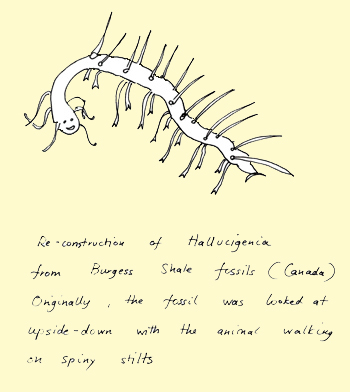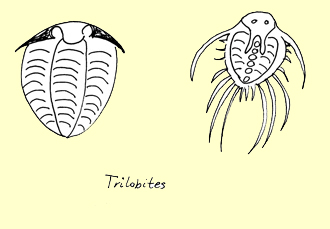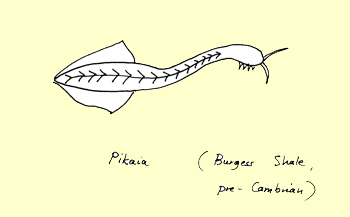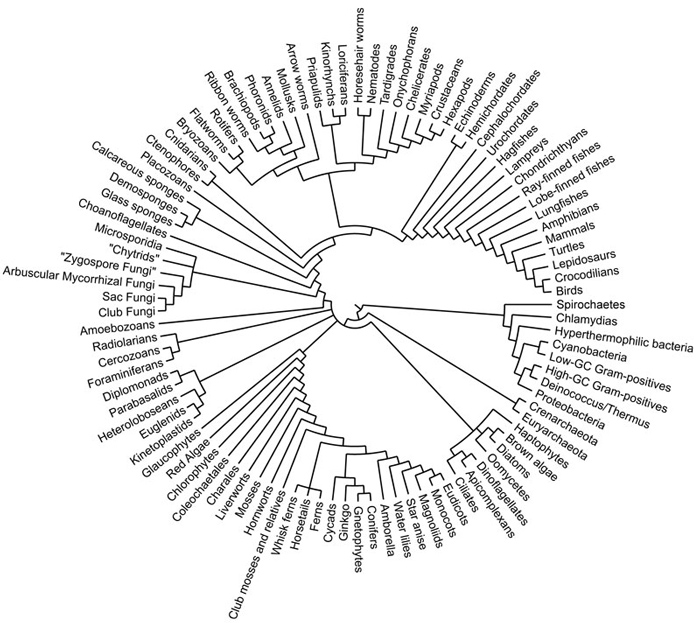



The first performance of Variation and Adaptation took place in Amgueddfa Cymru, the National Museum of Wales, on October 24th 2015.
Some of the most dramatic events in the evolution of life on earth were portrayed musically using a mixture of improvisation, devising, and scored music. The texts of the choruses were drawn from or inspired by writings by scientists such as Charles Darwin, E.O. Wilson and Stephen Jay Gould.
Footloose worked with a group of talented children from Coed-y-Gof Welsh medium school over one day producing a series of instrumental improvisations on themes such as the Cambrian Explosion, and the emergence of arthropods, insects and dinosaurs. We fitted mammals into a short section at the end since our history is so brief compared to other beings.
A special choir for the occasion worked really hard to learn the choruses, accompanied by members of the Radnor Improvisers, and we performed in the museum entrance hall of Amgueddfa Cymru. Special thanks to Lucy and Heidi for all their advice and support.
The piece is scored and notated and there are plans for more performances later this year.
Text from Stephen Jay Gould, 'Wonderful Life'
Stephen Jay Gould was an evolutionary biologist, paleontologist, and prolific author who wrote articles and books for the general public as well as more academic texts.
The tiny twig refers to the human tendency to think of ourselves as so important, because of our fixation with technological progress. The fact is that in terms of biomass we are vastly outweighed by insects and even more by bacteria. Our place on the Tree of Life is a small dot in the animals section, somewhere between slime moulds and fungi. 'We are a tiny twig on the massive Tree of Life, that never would produce the same set of branches if re-grown from seed. We grasp at the straw of progress'
Bacteria
The opening text is adapted from Stephen Jay Gould's observations in the previously-mentioned Wonderful Life.
Gould points out that we have always lived in the Age of Bacteria.
The three great domains of life: Archaea, Eukarya, and Bacteria are now generally accepted by scientists and are the result of the work of Carl Woese, who spent years analysing the genetic codes of different life forms and reconfiguring the Tree of Life. Archaea was a new classification, referring to the most ancient microbes, including for example, the extremophiles that live off methane and sulphur in super-hot chemical vents in the sea bed. At the time of his research, many other scientists dismissed Woese's work, but eventually he did get recognition and general acceptance of his theories.
By re-drawing the Tree of Life and basing its taxonomy on genetic relationships, yet another blow was dealt to the idea that humans are at the pinnacle of some evolutionary process that had to result in us. In fact, we really are just a tiny twig on the tree of life, and you could say that trees, elephants and beetles are our cousins, aunts and uncles.
Bacteria, bacteria, the stayers and the keepers of life's history
Bacteria, bacteria, resplendent in magnificent diversity
We thrive beneath the ocean on methane and sulphur
Deep within your body we help you stay alive
Decompose dead matter, make the soil for plants
Fermenting, creating, proliferating
Billions and billions and billions and billions of years of evolution
One of the three great domains of life:
Archaea, Eukarya, Bacteria!
CGAT improvisation
CGAT are the initials of the four units comprising the genetic code for DNA – Cytosine, Guanine, Adenine and Thymine. Coding takes place in the cell nucleus.
Frango
Frango ut Patefacium is the motto of the American Paleontological Society.
Darwin was mystified by the absence of pre-Cambrian fossils. He was sure that the earth was much older than most people believed at the time, and knew that life could not have started just at the point of the Cambrian explosion. But he lacked the evidence to prove it; he thought that probably those ancient life forms were soft-bodied and so had disappeared without trace.
In the 20th century he was proved right, when the extraordinary pre-Cambrian Vendian animal fossils, dated from about 560 million years ago,were discovered in 1946 by a geologist in Ediacara Hills, Australia. Other similar fossils were also found at Mistaken Point, Newfoundland, the White Sea in N. Russia, and Carmarthenshire in Wales.
Subsequently, as geological and dating techniques developed, scientists have identified ancient microbial life dating from at least three and a half billion years ago. These include stromatolites, built up by layer after layer of photosynthesising cyanobacteria. Living stromatolites have been found dating from 2,000 – 3,000 years old, which give an idea of how life might have been in Precambrian times.
The oxygen released by stromatolites built up over millions of years in the earth's atmosphere, eventually making it possible for oxygen-breathing organisms to develop, like ourselves.
The 'other seekers' refer to men and women throughout time who have taken risks and challenged the prevailing orthodoxy of their era in order to increase our collective knowledge and understanding of life's processes. These include figures such as Joseph Priestley, the dissenting cleric whose house and library in Birmingham were burnt to the ground in 1790, or his colleague, Charles Darwin's own grandfather Erasmus, who - shockingly for the time - suggested that humans were desceneded from minute marine organisms.
The work of geologists has been profoundly important in helping us understand the evolution of life on earth.

Frango ut patefacium - I break in order to reveal
Gaps, gaps, gaps in the fossil record keep Darwin awake at night!
Searching, asking, looking for knowledge, searching, asking..
Other seekers too, have been guardians of knowledge,
Wrote secretly in books and ancient manuscripts,
Protected libraries and places of learning,
Heretics, dissenters, who dared to question - risked prison, torture, even death -
To delve into mystery and bring truth to light.
Duplication/Replication
How do cells replicate and multiply themselves?
Having been coded by DNA contained in chromosomes in the cell's nucleus, using the CGAT units, the DNA instructions are 'read' by RNA in a process called transcription. They are then made into proteins – this is called translation.The DNA code determines the order of the amino acids that make up the protein for different enzymes responsible for biochemical reactions in the cell. If the code is damaged or altered in any way this may cause mutations.
The allele is one of a number of different forms of the same gene. These can cause variations in, for example, eye or hair colour, passed from one generation to another.
Du du du Plic!
Du plic a tion
Rep-li-ca tion
Genetic information passed down through generations
With variations
RNA DNA
Transcription
Translation
Exchange of information
Making proteins
Building structures
Filaments and fibres
Alle - alle - allele
mmm Mighty Mitochondria
Mitochondria were probably independent, individual living cells that merged with other single celled organisms and evolved symbiotically. Mitochondrial DNA is passed through the female line only. Mitochondria exist in almost every cell of all multi-celled organisms: they convert oxygen into energy in the form of ATP that is essential to keep us alive.
But more than that, recent research proves that mitochondria migrate around the cell and can multiply when greater energy is needed. They mutate more quickly than other DNA. They can boost the transmission of electrical energy needed for memory and thought. They control the availability of calcium in the body and seem to be much more important in genome expansion and variation than originally thought. We are born with multiple mitochondrial DNA variations in our cells, transmitted from our mothers.
Mmmm, M mmm mm
Mighty, mighty
Mighty mitochondria
Free-living!
Bacterial and ancient
Invader, invader!
Generating energy
Transporting oxygen
Strengthening immunity
Free radical!
Mitochondrial mutations
Speed up genetic adaptations
With multiple variations
And exquisite adaptations
To external situations
Originating at the time of
Fertilisation!

Song of the Trilobite, adapted from the poem, the Lay of the Trilobite, by Kay Kendall, 1847
I discovered this wonderful poem in 'The Trilobite Book, by Ricardo Levi-Setti, and have slightly adapted it for the song.
Trilobites appear in the fossil record in the early Cambrian era, over 520 million years ago. They were an ancient form of arthropod - an animal with jointed legs, exoskeleton and segmented bodies - who roamed the seas for over 270 million years, eventually disappearing just before the mass Permian extinction about 250 million years ago. New kinds of trilobite are continually being discovered, and are often very well-preserved. Later trilobites developed spines, probably as a defensive response to fearsome predators.
The Huxley referred to is Thomas Huxley, Darwin's great friend and passionate and public defender of his theories. He wrote in a letter to Darwin just after the publication of the Origin of Species in 1859:
'As for your doctrines I am prepared to go to the Stake if requisite. . .I trust you will not allow yourself to be in any way disgusted or annoyed by the considerable abuse & misrepresentation which unless I greatly mistake is in store for you. . . And as to the curs which will bark and yelp -- you must recollect that some of your friends at any rate are endowed with an amount of combativeness which (though you have often & justly rebuked it) may stand you in good stead - I am sharpening up my claws and beak in readiness'
As I wandered ill at ease, there chanced upon my sight
A native of Silurian seas, an ancient Trilobite
Then quite quite natural and free, out of his rocky bed
That Trilobite, he spoke to me, and this is what he said
'I don't know how the thing was done, although I cannot doubt it
But Huxley, he if anyone, could tell you all about it
How you evolved your shining lights of wisdom and perfection
From jellyfish and trilobites, by Natural Selection.
The native of an alien land you call a man and brother
And greet with hymn-book in one hand, and pistol in the other!
You've politics to make you fight as if you were posessed
You've cannon and you've dynamite to give the nations rest
The side that makes the loudest din is surest to be right
And oh, a pretty fix you're in' – remarked the Trilobite.
I wish our brains were not so good, I wish our skulls were thicker
I wish that evolution could have stopped a little quicker
For oh, it was a happy plight of liberty and ease
To be a simple trilobite in the Silurian seas!

Pikaia
Inspired by the book 'Planet of the Bugs' by Scott Richard Shaw.
Pikaia was a tiny, wormlike creature discovered in the Burgess Shale fossils in Canada. She was soft-bodied but had a primitive notochord - an internal supporting structure that was the precursor of the spinal column found in vertebrates such as mammals and reptiles. Because Pikaia had no body armour she had to stay in the sediment on the sea bed to avoid being eaten by scary huge arthropods with spines - including some of the less peaceful trilobites.
Had Pikaia not survived, it's possible that vertebrates would never have evolved and arthropods would have ruled both ocean and land. No dinosaurs!
Hiding in the sea bed,
Tunnelling through sediment
Soft-bodied, vulnerable,
All vertebrates descend from her
Pikaia, tiny and soft
Pikaia, survivor
Vulnerable, hiding away
Our common ancestor
Threatened by monsters above
Clinging on to life
Pikaia, survivor,
Our common ancestor
Fish, amphibians, reptiles, dinosaurs
Birds and mammals
All descend from her

Brave Arthropods
This song is also inspired by the same book by Scott Richard Shaw.
He describes the courage of those first arthropods who left the safety of the ocean to try out terrestrial life -S thereby starting the whole process of evolution of animals on land into other arthropods, insects, and eventually dinosaurs, birds and mammals.
They put their little legs out onto the shore
Brave arthropods wanted to know more
Crawling out of the sea, onto the sand
The first animals to try out land.
Brave arthropods, brave arthropods, brave arthropods wanted to know more.
Oh how different it was out there
They had to learn how to live in air.
Then millions and millions of years went by
They developed wings and learnt to fly.
Brave arthropods etc
They co-evolved with plants and trees
Happy on land away from the seas.
Now as they flap and buzz away
Remember that momentous day
Brave arthropods etc

An Abominable Mystery
This was what Darwin called the evolution of flowering plants, or angiosperms as they are sometimes called - how come they suddenly emerge into the fossil record pretty much in one go, all over the earth? At the time, the fossilised flowering plants that had been discovered dated from the Cretaceous era, the time of the last dinosaurs.
But later, pollen dating techniques using molecular biology have posited that the evolution of flowering plants may have been more gradual than at first supposed. Recent evidence suggests that the predecessors of the first flowering plants may actually date from over 200 million years ago. The extinct group of plants known as the Gigantopterids share chemical traits with later flowering plants. Since the first flowers came on the scene they have co-evolved with insects and other animals including humans. For example, humans have consistently preferred certain flowers for their smell, colour, or medicinal properties and have cultivated them while relegating other plants to the status of weeds.
Gaps gaps gaps
Gaps in the pollen record
Are a most perplexing phenomenon
An abominable mystery
Flowering plants!
First there were horsetails and mosses
In the Carboniferous swamps
Then ferns and gingkos and conifers
Expanding alongside the conifers
Then in the Cretaceous
The wonder of flowers and fruits!
Water lilies
Daisies, magnolia, banyans and orchids
Roses and cabbages, chestnut and hazel
Apples Bananas Mangoes Pears!
Food for the hungry, shade for the weary
Tropical forests buzzing with insects
Longing for nectar
Food for the hungry, shade for the weary
Meadow and pasture buzzing with insects
Longing for nectar
Food for the hungry, shade for the weary
Warm summer days heavy with blossom
Humming with insects

Mary Anning
Mary Anning lived in Lyme Regis 1799 – 1847, where the limestone cliffs date from the Jurassic era.
'Lightning child' refers to the fact that as a baby she survived a lighting strike that killed the woman holding her.
Her father, Richard Anning, was a carpenter and the family was poor: he taught Mary and her brother Joseph to gather shells and rocks to sell at his stall on the beach. When he died in a cliff fall in 1810, Mary continued the work, which was dangerous because the best time to do it was in the winter when storms exposed the fossils in the rocks, but then there was risk of lethal land slides. Joseph died while fossil hunting, and Mary herself nearly died in a landslide that killed her dog.
In 1811 Mary and her brother found the first ichthyosaurus - fish-lizard - and subsequently chipped out many more, including the long-necked Plesiosaurus, the ‘sea-dragon', in 1823.
Too poor to go to school, Mary taught herself to read and write, and succeeded in gaining the attention and interest of contemporary male scientists such as William Buckland, and the French anatomist Georges Cuvier, although generally they were very slow to credit her for her work. Her discoveries helped to explode the biblical myth that all life emerged at once, perfected by God, and never changed. It also meant that the earth was much older than people had thought.
The fact that Mary Anning was female and working class prevented her from gaining the recognition she deserved and she remained poor until her death from cancer.
In 2010, one hundred and sixty-three years after her death, the Royal Society finally included her in a list of the ten British women who have most influenced the history of science.
Mary Anning, lightning child
Braved winter storms to search the cliffs at Lyme Regis
Chipping ancient stories from the blue grey rocks
She never went to school, was hardly recognised,
An outcast in her time
Mary Anning died in loneliness and poverty, though her work was great
For she revealed a priceless truth -
A far older earth
Ichthyosaurus swimming in the ancient ocean
Millions and millions of years ago
Everything Changes
The first part of the text is drawn from the writings of Denis Diderot, philospher and freethinker living in eighteenth century pre-revolutionary Paris. He was arrested and imprisoned for his writings that questioned the supremacy of the Catholic religion, and his book 'Pensees philosohiques' was burnt by order of the Paris parliament. His last book, d'Alembert's Dream, describes a changing universe in constant flux, where all living things are related and have a common origin.
E.O Wilson - 'Extinction is for ever' has written many books about ecology including The Diversity of Life from which this quote is taken. He has been extremely influential in developing conservation biology and drawing public attention to the negative impact of human activities on other species, through destruction of habitats and eco-systems.
Tout est un flux perpetuel
Everything changes, only the whole remains
Oikos, logos, cartref, domus, sciens, deall, humanus
Every creature is unique, all are our distant kin
Extinction is for ever
........
From Virgil - Avernus is the ancient name for an existing volcanic crater at Cuma, near Naples in Italy, which was believed to be the entrance to the underworld and was described in Virgil's Aeneid. Dis or Dis Pater was a god of the underworld who preceded Pluto and the Greek Hades.
The way downward is easy to Avernus,
Black Dis's door stands open night and day
But to retrace your steps to Heaven's air
There is the trouble, there is the toil.
Humble Bee
From the Origin of Species
Humble bee was the original name for bumble bee and refers to the sound they make, not that they are humble.
Well before the indiscriminate use of pesticides, Darwin warned of the catastrophic effects that extinction of one of our major pollinators would cause.
If the whole genus of humble bees should go extinct, or very near
The heartsease and red clover would surely disappear
There is Grandeur in this View of Life
This is taken from the last paragraph of The Origin of Species, and says it all really.
Darwin's book, which he took so long to write and publish, had a huge impact on scientific thought at the time. Other, earlier, scientists and thinkers had already come closer to understanding evolution, and questioned the conventional, biblical theories of life and creation. Darwin's contemporary, Alfred Russel Wallace, hit upon the theory of natural selection almost at the same time as Darwin. But the beautifully written book, the Origin of Species, that took twenty years to complete, was and remains a colossal work, that still echoes down the years as scientists continue to unravel the mystery of life's processes.
There is grandeur in this view of life, with its several powers...originally breathed into a few forms or one..while the planet goes cycling on...
From so simple a beginning, endless forms most beautiful, and most wonderful, have been, or are being evolved.

Download mp3 recordings from the performance here:
Bacteria
Dinosaurs
Diversity of life improvisation
Insect improvisation
Mighty mitochondria
Teeth, spines and skeletons
There is grandeur
Trilobite










